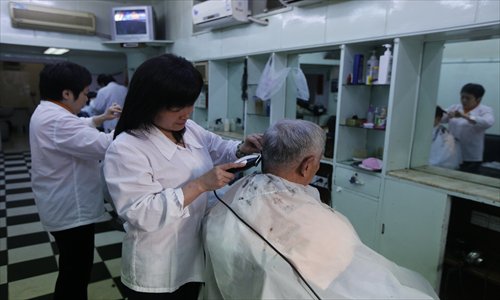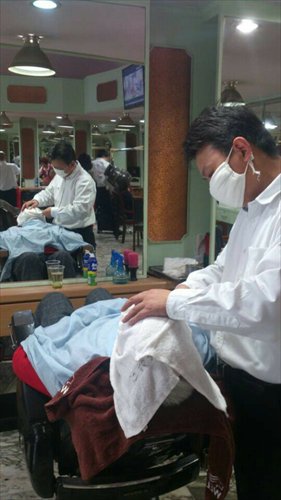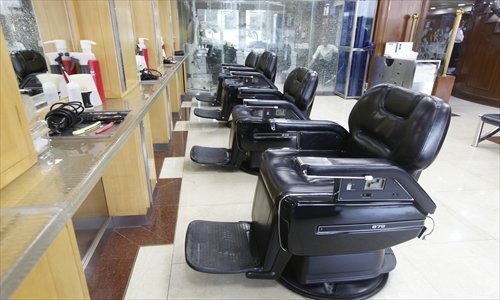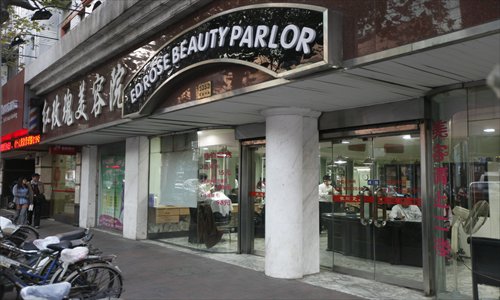Hair today

Long-standing hair salons still do brisk business catering to the particular demands of senior citizens. Photos: Cai Xianmin/GT and Sun Shuangjie/GT
Hair salons typically rely on projecting a hip, youthful image; employees are funkily coiffed and rarely look over 35, and top 40 hits are blared from speakers. They're not the kind of businesses that would boast fusty descriptors like "time-honored" and "State-owned." But there are a few establishments in the city that continue to trade on their impressive histories.
Staffed by experienced old hands, these long-standing salons still do brisk business catering to the particular demands of senior citizens and have even become hip choices for a nostalgic younger crowd.

Long-standing hair salons still do brisk business catering to the particular demands of senior citizens. Photos: Cai Xianmin/GT and Sun Shuangjie/GT
Nanjing: old and young
Before the mid-1990s, even in fashion-conscious Shanghai, State-owned hair salons were the place to get a haircut. Together with Hua'an, Xinxin and Hujiang, Nanjing Salon was one the four most famous hair salons in the city.
The first Nanjing salon was opened in 1933 by a Chinese businessman who bought all his hairdressing equipment from the US. The 500-square-meter shop was the biggest salon in the city.
Celebrities such as Soong Mei-ling and actresses Ruan Lingyu and Hu Die were among Nanjing's earliest regular patrons.
After 1949, the salon was made a State-owned enterprise for years, serving the families of local dignitaries. Though the well-established chain, which has five locations downtown, is no longer State-owned, its traditional services have remained.
Ornamented in a distinctive modern style, the largest Nanjing Hair & Beauty Salon (784 Nanjing Road West, 6253-2958) features crystal curtains and a huge crystal chandelier.
However, the two rows of heavy, vintage leather chairs arranged before the mirrors are reminders of Nanjing's glorious past.
"A single chair cost more than 100,000 yuan ($16,415) in the 1980s, which was enough to buy an apartment in Shanghai then," Hu Haidi, the assistant manager in the shop, said with pride.
The front part of the first floor is reserved for male customers, who can opt for a fashionable look from one of the young stylists or turn to an experienced barber for traditional services, such as a shave.
Skincare and massage treatments are administered in the back part of the ground floor, while the second floor, dominated by a hue of pink, caters for female clientele.
Nanjing has retained its high-end reputation despite offering very competitive prices. A wash, cut and blow-dry starts from 60 yuan at Nanjing, while dyeing starts from 200 yuan and perms from 300 yuan.

Long-standing hair salons still do brisk business catering to the particular demands of senior citizens. Photos: Cai Xianmin/GT and Sun Shuangjie/GT
Paradise for fashionistas
Red Rose Beauty Parlor (1352 Huaihai Road Middle, 6437-7213) was also revered as one of Shanghai's high-end salons. In the early 1990s, Red Rose introduced advanced perm machines, drawing a chic clientele.
Famous Shanghainese comedian and anchorman Chen Guoqing, better known as Ah Qing, is known to be a regular patron at Red Rose.
However, prices at the once-hip salon are no longer considered expensive; a haircut now costs 55 yuan.
The average age of the stylists at Red Rose is over 50, a hairdresser surnamed Liu told the Global Times. Liu, who only serves female customers, has been working in the business for more than 30 years. "The barbers for male customers can still each contribute roughly 20,000 yuan of revenue per month for the shop," said Liu, who noted that business at Red Rose, though not as competitive as it was in the 1990s, is still satisfactory.
The main room, which looks almost the way it did 20 years ago, features a marble floor, a pink ceiling and light green walls ornamented with golden frames. The old perming machines, which are fixed on the wall, still work well now and when needed, they will extend their arms to customers like mechanic robots.
But Liu told the Global Times that the State-owned business will likely close for good when its stylists reach retirement age.

Long-standing hair salons still do brisk business catering to the particular demands of senior citizens. Photos: Cai Xianmin/GT and Sun Shuangjie/GT
Neighborhood stalwart
An uncertain future also awaits the State-owned Xinghuo Barbershop (291 Damuqiao Road, 6416-4434), which has been serving loyal customers in the neighborhood for decades.
Located in a small room in Xuhui district, Xinghuo opened in the 1950s and caters to the laobaixing, ordinary folks, with low prices. Even today a haircut at Xinghuo costs just 12 yuan.
Compared to the retro glamour of Nanjing and Red Rose, the interior of Xinghuo is rather humble: the plain mirrors are installed in a row of thin, light green cabinets on one side of the room, and a long black leather sofa sits at the other side for customers to wait and lay their belongings; further inside are sinks, but here customers have to sit and stick their heads forward to have their hair washed under a tap.
There are now six hairdressers working at Xinghuo, most of them in their 40s or 50s, who have been snipping and trimming for so many years that can comfortably see dozens of customers a day. "A haircut for male customers with short hair is finished in roughly five minutes, while a shave and a haircut usually takes about 30 minutes," said a stylist surnamed Zhang, who has worked in the field for 20 years. Each day Zhang will serve at least 40 customers.
"It's really a delight to see the people who came here as children now bringing their own kids to get haircuts," Zhang said. She is due to retire in four years, but has made lifelong friends with her regular customers.